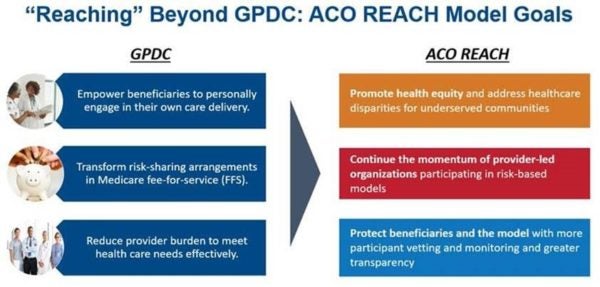On February 24, 2022, the Centers for Medicare & Medicaid Services (CMS) announced its redesign of the Global and Professional Direct Contracting Model (GPDC), which now will be called the Accountable Care Organization (ACO) Realizing Equity, Access, and Community Health (REACH) Model.
The REACH Model builds on CMS’s ten years of experience with accountable care initiatives, such as the Medicare Shared Savings Program, the Pioneer ACO Model, and the Next Generation ACO Model. CMS created the REACH Model to better reflect the priorities of the Biden-Harris Administration, to highlight changes due to feedback received from participants and stakeholders, and to affirm its commitment to health equity as central to improving quality of care. Indeed, key goals of the REACH Model are to improve quality of care and care coordination for patients in traditional Medicare, especially for patients in underserved communities.
The REACH Model will allow participation by three participant types:
-
Standard ACOs: For organizations with substantial experience serving people with Traditional Medicare.
-
New Entrant ACOs: For organizations with less experience serving the Traditional Medicare population.
-
High Needs Population ACOs: For organizations that serve small Traditional Medicare populations with complex health care needs.
Participants in the REACH Model will be referred to as “REACH ACOs.”
Like the GPDC Model, the REACH Model will offer two voluntary risk sharing options:
-
Professional Option (Professional): A lower-risk option with 50 percent Shared Savings/Shared Losses and Primary Care Capitation Payment.
-
Global Option (Global): A full risk option with 100 percent Shared Savings/Shared Losses and either Primary Care Capitation Payment or Total Care Capitation Payment.
The risk-sharing options involve two capitation payment mechanisms:
-
Total Care Capitation (TCC) Payment: A per-beneficiary, per-month (PBPM) capitated payment for all services provided to aligned beneficiaries by all participant providers and those preferred providers who have opted to participate in TCC Payment.
-
Primary Care Capitation (PCC) Payment: A PBPM capitated payment for primary care services provided to aligned beneficiaries by all participant providers and those preferred providers who have opted to participate in PCC Payment.
CMS believes the REACH Model will improve risk adjustment when compared with the GDPC Model in two key ways:
-
The REACH Model caps the risk score growth of each individual model participant at +/- 3 percent over a two-year period. Some fluctuation in risk scores will be allowed, but this risk score cap ensures no single participant’s risk scores grow too fast.
-
The REACH Model locks in the average risk score across the entire model from before the REACH Model began, to ensure that risk scores within the REACH Model do not grow faster than risk scores in traditional Medicare. This allegedly creates a ‘zero-sum’ environment and is the mechanism that provides 100 percent protection to Medicare against inflated payments.
The aggregate amount of savings or losses that ACOs in the Global or Professional options will be eligible to receive as Shared Savings or be required to repay as Shared Losses will be constrained by a series of risk corridors. In addition, a stop-loss arrangement will be an optional feature of both Global and Professional, to reduce the financial uncertainty associated with infrequent, but high-cost, expenditures for aligned beneficiaries.
In addition, the REACH Model will make three “priority” changes to the GPDC Model:
-
The REACH Model will use an innovative payment approach to better support care delivery and coordination related to patients in underserved communities, and will require all model participants develop a robust health equity plan to reduce health disparities within beneficiary populations. The CMS Innovation Center will provide participants with a template based on the CMS Disparities Impact Statement created by the CMS Office of Minority Health to identify health disparities, define health equity goals, establish a health equity strategy, and a plan for implementing the health equity strategy and monitoring and evaluating progress to advance health equity for underserved communities.
-
The REACH Model will encourage doctors and other health care providers to continue playing a primary role in accountable care, including by requiring that 75 percent control of the ACO’s governing body be held by participant providers or their designated representatives (an increase from the 25 percent control requirement under the GPDC Model). The ACO may seek an exception from the 75 percent control requirement by submitting a proposal to CMS describing the current composition of the ACO’s governing body and how the ACO will involve participant providers in innovative ways in ACO governance. In addition, the governing body must include at least one Medicare beneficiary and one consumer advocate (different people) with voting rights.
-
The REACH Model will enhance beneficiary protections by conducting deeper up-front applicant screens and more robust monitoring of participants, including stronger protections against inappropriate coding/risk score growth. For example, these activities will include increased use of data analytics to monitor use of services over time; assessing annually whether beneficiaries are being shifted into or out of Medicare Advantage; continuation of audits of contracts ACOs have with providers; examining ACOs’ risk score growth to identify inappropriate coding behaviors; monitoring for noncompliance with prohibitions against anti-competitive behavior and misuse of beneficiary data; reviewing marketing materials to ensure information is accurate; and investigating beneficiary complaints and grievances. Also, the REACH Model will afford greater transparency into its implementation progress, including sharing more information on participants.
CMS summarizes these three points in the following diagram:

According to Liz Fowler, PhD, JD, CMS Deputy Administrator and Director of the CMS Innovation Center, “[u]nder the ACO REACH Model, health care providers can receive more predictable revenue and use those dollars more flexibly to meet their patients’ needs — and to be more resilient in the face of health challenges like the current public health pandemic.”
A detailed comparison between the GPDC Model and REACH Model can be found here, general information on the REACH Model can be found here, and the REACH Model Request for Application can be found here.
New participation in the REACH Model will begin on January 1, 2023 and run for three years through 2026. The application period for Performance Year 2023 and the optional Implementation Period (running August 1, 2022 through December 31, 2023) is March 7, 2022 to April 22, 2022, with REACH ACO selection occurring in approximately June 2022. Although the GPDC Model will continue until December 31, 2022, current GPDC Model participants must agree to meet REACH Model requirements by January 1, 2023, to continue participation (a new application is not required).



 />i
/>i


